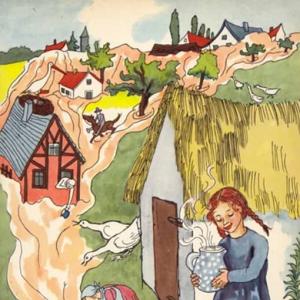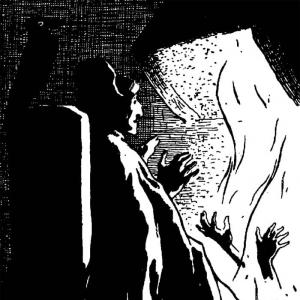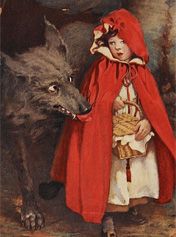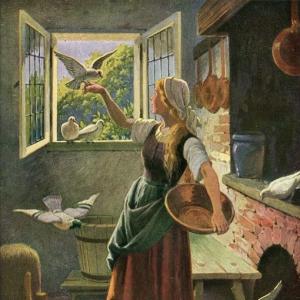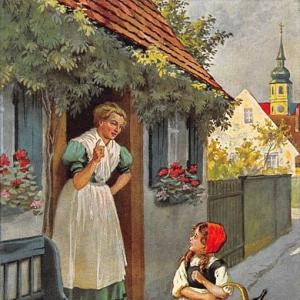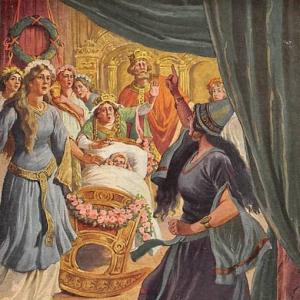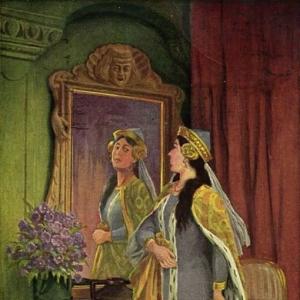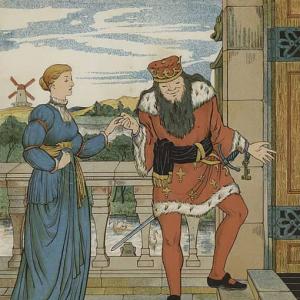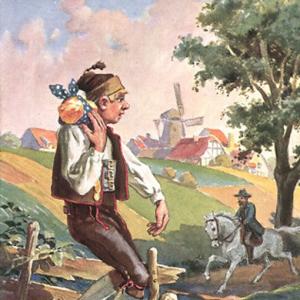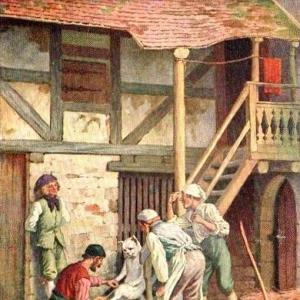Reading time: 5 min
Once upon a time, there was a king who had three daughters. He desired to find out which of the three loved him the most. So he called them forth, and posed the question to each: „How much do you love me?“ The first said that she loved him more than the whole kingdom.
The second that she loved him more than all the jewels and pearls in the world. When the third daughter declared that she loved him more than salt, he flew into a rage. Then he ordered his servant to carry the little girl into the woods and kill her.
Yet when they reached the lonely wood, the servant told her that he was devoted to her and would not have killed her under any circumstance. He was delighted to agree to her plan: that he make her a tunic of mouseskins, and leave her to make her own way. When it was done, the girl wrapped herself in it and went straight to the neighboring king and asked for employment.
She had cut her hair short, and said she was a boy, and the king believed her, and took her on as his personal servant. Now it was the king’s habit, when taking his boots off at night, to throw them at his serving boy’s head. One night, the king asked the lad in mouseskins where he had come from.
The youth replied: „From the country where one doesn’t toss boots at people’s heads!“ From that moment, the king was suspicious of the boy, and set the other servants to spying on him. When they discovered a ring in the mouseskin boy’s chamber, they brought it to the king. It was of such valued that they thought [s]he had stolen it.
The king called Mouseskin to him and and asked how she obtained the ring. That’s when she realized that she could not hide herself any longer. She unwrapped the mouseskin, and her golden hair streamed down. As she stepped out of the skin, he could see she was beautiful, indeed so beautiful that he immediately took off his crown, put it on her head, and declared her to be his wife.
A grand wedding was celebrated and all of the neighboring kings, including Mouseskin’s very own father, were invited. But although the guests were entertained with the most delicious wines, the most graceful dancers, and the most elegant dishes, the food itself seemed to have no taste. One king became irritated and said: „I’d rather die than eat such food!“
No sooner had he uttered those words than his daughter, the new Queen, came to his side. That is when she said: „Well, now you say you can’t live without salt, but when I said I loved you more than salt, you wanted to have me killed.“
And all of a sudden, the grumpy old king realized that this young woman was none other than his youngest daughter, who he had believed to be long dead. In joy, he kissed her, and begged her forgiveness. Now that he had found her again, she was more dear to him than his kingdom and all the jewels in the world.
 Learn languages. Double-tap on a word.Learn languages in context with Childstories.org and Deepl.com.
Learn languages. Double-tap on a word.Learn languages in context with Childstories.org and Deepl.com.Backgrounds
Interpretations
Summary
Linguistics
„Princess Mouseskin“ is a lesser-known fairy tale from the Brothers Grimm, Jacob and Wilhelm Grimm, who were German academics, linguists, cultural researchers, and authors. They are famous for their collection of European folk tales, which aimed to preserve and document the rich oral tradition of storytelling. Their collection, „Grimm’s Fairy Tales“ (originally titled „Children’s and Household Tales“), was first published in 1812 and has since become an influential source of folklore and inspiration for various adaptations in literature, theater, and film.
„Princess Mouseskin“ is a variant of the Aarne-Thompson folktale type 510B, which includes stories of persecuted heroines who disguise themselves and flee their homes. Other well-known stories in this category include „Cinderella“ and „Donkeyskin.“ The tale shares themes and motifs with these stories, such as the transformation of the heroine, the symbolic importance of clothing, and the eventual recognition of the heroine’s true identity.
While the Brothers Grimm are known for popularizing this version of the tale, similar stories with different names and variations can be found in other cultures, such as „The King Who Wished to Marry His Daughter“ from Scotland and „The She-Bear“ from Italy. The story’s prevalence across different cultures reflects the universal themes of love, resilience, and transformation that resonate with audiences worldwide.
„Princess Mouseskin“ can be interpreted through various themes and lessons:
The value of love and understanding: The king’s initial reaction to his youngest daughter’s declaration of love reflects his inability to appreciate the depth of her feelings. Only later does he realize the true value of her love, which is more important than material possessions.
The power of forgiveness: Despite the king’s harsh treatment of his daughter, she forgives him in the end. This theme emphasizes the importance of forgiveness and the possibility of redemption for those who have made mistakes.
Don’t judge a book by its cover: The princess’s disguise as a mouseskin-clad servant demonstrates the importance of looking beyond appearances to understand a person’s true worth. Her beauty is only revealed after her mouseskin is removed, showing that sometimes, the most valuable qualities are hidden beneath the surface.
The importance of humility and resilience: The princess’s decision to disguise herself and find work as a servant highlights her humility and willingness to adapt to new circumstances. This resilience ultimately leads to her discovery and a happy resolution.
The significance of simple things: The story emphasizes the importance of seemingly mundane things, like salt, which can have a profound impact on our lives. The absence of salt at the wedding feast serves as a metaphor for the essential nature of love and appreciation in our lives.
„Princess Mouseskin“ is a Brothers Grimm fairy tale about a king who wishes to know which of his three daughters loves him the most. Each daughter expresses her love differently, but when the youngest claims to love him more than salt, he becomes enraged and orders her execution. Instead of killing her, the servant helps her devise a plan to escape, crafting her a tunic made of mouseskins.
Disguised as a boy, she finds employment as a servant in a neighboring kingdom. However, her true identity is eventually discovered due to her possession of a valuable ring. Upon revealing herself, the neighboring king is captivated by her beauty and declares her his wife.
During the grand wedding celebration, the guests notice that the food lacks taste, prompting the princess’s father to exclaim he would rather die than eat such food. The princess confronts her father, reminding him of how he had dismissed her love. The father realizes she is his lost daughter and joyfully reunites with her, cherishing her more than his kingdom and all the jewels in the world.
The fairy tale „Princess Mouseskin,“ attributed to the Brothers Grimm, invites a linguistic and thematic analysis that highlights several narrative and cultural elements.
Narrative Structure: The tale follows a classic fairy tale structure with an initial situation, conflict, climax, and resolution. The initial question posed by the king sets the story in motion, triggering a series of events that lead to the conflict (the daughter’s banishment), the climax (revelation of the daughter’s identity), and the resolution (reconciliation and celebration).
Characterization and Dialogue: The king is portrayed as capricious and superficial in his understanding of love. His inability to see the value in his daughter’s comparison to salt underscores his lack of emotional depth. This misjudgment serves as a critical commentary on how literal interpretations can lead to misfortunate actions. The third daughter’s response — loving her father „more than salt“ — is initially misunderstood, but ultimately proves wise. Salt, a basic yet essential element, symbolizes the fundamental, indispensable love she has for her father.
Symbolism
Salt: Central to the narrative’s moral, salt symbolizes fundamental importance and necessity, highlighting how essential yet underappreciated elements hold their value quiet strength.
Mouseskins: Represent transformation, concealment, and survival. They serve as a means for the princess to navigate her unjust circumstances.
Golden Hair: Symbolizes purity and true identity, leading to revelation and recognition.
Themes
Misunderstanding and Redemption: The tale revolves around the king’s misunderstanding of his daughter’s metaphorical expression of love and the eventual realization of her wisdom, leading to reconciliation and redemption.
Deception and Identity: The princess’s disguise speaks to themes of hidden identity and the social dynamics of deception for self-preservation.
Values and Priorities: The story critiques materialism, as the king learns to value his daughter’s love over material wealth.
Cultural Context: The tale reflects societal norms and family dynamics, with the father holding absolute power over his children’s fates. The daughter’s eventual empowerment and the father’s change of heart suggest a moral about the importance of seeing beyond superficial values.
In conclusion, „Princess Mouseskin“ offers a rich landscape for linguistic and thematic exploration, revealing timeless lessons on the nature of love, identity, and the complexity of human values. Through its narrative and symbolic elements, the story conveys how true worth is often found in the seemingly mundane but essential aspects of life.
Information for scientific analysis
Fairy tale statistics | Value |
|---|---|
| Number | KHM 71a |
| Aarne-Thompson-Uther-Index | ATU 510B |
| Readability Index by Björnsson | 31.1 |
| Flesch-Reading-Ease Index | 82.6 |
| Flesch–Kincaid Grade-Level | 6.3 |
| Gunning Fog Index | 9.3 |
| Coleman–Liau Index | 8.4 |
| SMOG Index | 8.9 |
| Automated Readability Index | 7.1 |
| Character Count | 2.848 |
| Letter Count | 2.194 |
| Sentence Count | 29 |
| Word Count | 533 |
| Average Words per Sentence | 18,38 |
| Words with more than 6 letters | 68 |
| Percentage of long words | 12.8% |
| Number of Syllables | 665 |
| Average Syllables per Word | 1,25 |
| Words with three Syllables | 28 |
| Percentage Words with three Syllables | 5.3% |

 Facebook
Facebook  Whatsapp
Whatsapp  Messenger
Messenger  Telegram
Telegram Reddit
Reddit